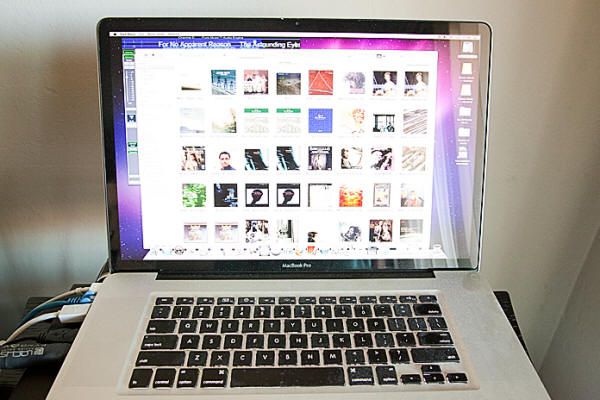|
You are reading the older HTML site
Positive Feedback ISSUE 56
Pure Music: Not Just an Alternative to Amarra
Windows echo your reflection
I will admit that I have a bias towards Amarra; it makes my music sound better and it easily docks alongside iTunes, which is still the simplest overall interface for managing music in the business, particularly if you're using a Mac (which I am). However, it's only fair to consider alternatives, particularly when they're less expensive (although there is Amarra Mini and Amarra Jr.) and I will fully admit that much of my fondness for Amarra comes from familiarity. It's what I used when I first started building a digital music server, back when I had a PS Audio PerfectWave DAC and about seventeen (17) feet of Locus Design Vision analog interconnects to reach my Meishu. Amarra, as I know it, kind of descends from the realm of professional audio and in some ways is not quite ready for prime time from the perspective of the average home user. It has a lot of windows; and new releases can be a little buggy. But it sounds SO good … Pure Music, by contrast, is definitely a plug and play application and in the classic Mac tradition comes preconfigured to get optimal results for the average user with little or no downside and a very polished look and feel; plus, it's extremely stable. However, like many Mac applications, the simple setup and basic good sound belies an underlying wealth of features of which I have only scratched the surface. I wrote the following in my last digital music server epilog:
I still feel that way, but my mind has been changed a bit by two features. One is "Memory Play" and the other is "Upsampling", which really should be called Resampling since—despite what the instructions imply—I can get it to simply change everything to 24/96 and then feed that through my Sonicweld Diverter… even if, as now, I am technically listening to the 24/192 copy of Waltz for Debby. And that's a very powerful feature because, for the most part, the original Sonicweld Diverter sounds best at 24/96 and I don't have to worry about using Sample Manager or dBpoweramp Music Converter to change the sample rate of my files to play optimally (or at all) through the Diverter. When I engage Memory Play and Upsampling with the target set as my Sonicweld Diverter at 96KHz, it appears to play flawlessly and the sound is genuinely effortless. It still lacks a kind of vacuum-tube midrange that I get from Amarra; but it's very clean and very clear and there is nothing wrong with the bass or treble. It mostly just sounds like music. And, as with Amarra (which has its own memory play feature), I don't have to worry so much about the medium from which the music is coming (RAID drive versus SSD, ETC.) because it's getting buffered through several megabytes—if not gigabytes—of RAM. Being a proponent of what Audio Note calls "1x oversampling", meaning no oversampling, I was a bit skeptical about the resampling performed by Pure Music; but as the instructions say (you always read the documentation, right?), "If you've avoided hardware upsamplers in the past, software upsampling is different. Available upsampling hardware operates with less than 64 bits of precision and the hardware logic circuitry needed for implementing the proper (complicated) reconstruction filters requires a prohibitively large (and expensive) amount of chip area." Basically that's a way of saying that you to do upsampling properly, you need a real computer and, voila, you already have one; otherwise, you wouldn't be running Pure Music. Now I mentioned the 24/192 copy of Waltz for Debby a minute ago; let me go to something else. Let me go to a 16/44.1, Apple Lossless compressed copy of the ECM CD, The Astounding Eyes of Rita by Anouar Brahem. I'm used to hearing Waltz for Debby at either 24/96 or 24/192 so there the resampling is a matter of convenience; and I can't say that memory play—in that case—made a huge difference in the sound; however, with, The Astounding Eyes of Rita, it's a whole different story. There's a depth and richness to the sound that kind of floored me and the unusual concoction allows instruments to harmonize in ways I had not expected. By the same token, using Apple's Remote Desktop to control my 17" MacBook Pro from my 11" MacBook Air, I queued up the 16/44.1 copy of Art Pepper Meets the Rhythm Section and was rather floored again at how close it came to my original stereo vinyl pressing in spirit if not in fact. Do I still prefer Amarra? I don't know. I queued up the 16/44.1 copy of Art Pepper and played it at its native resolution; I have to admit, there was a smoothness and melodious quality to it that moved me. At the same time, I didn't keep going, "That's great, that's really great." So the jury is still out. It's sort of like I say, on paper I like Amarra better but I feel more drawn to play music through Pure Music. Which one will win, if either, only time and future system configurations can tell. Kindest regards, Andy
When I look up to the sky
Pure Music http://www.channld.com/puremusic Ammara http://www.sonicstudio.com/amarra/productoverview.htm
|


